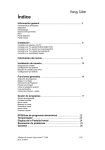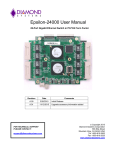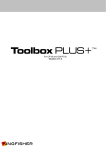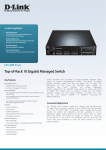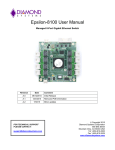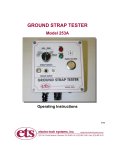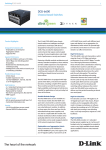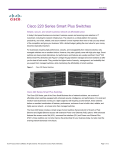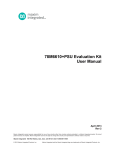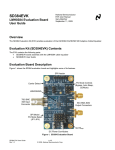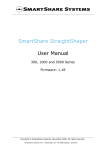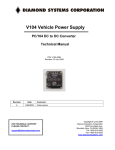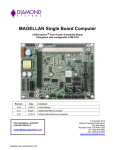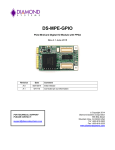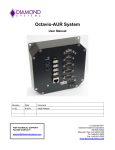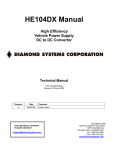Download Epsilon-12G2 User Manual - Diamond Systems Corporation
Transcript
Epsilon-12G2 User Manual Managed 14-Port Gigabit Ethernet Switch Part Number 7460440 Revision Date A.00 11/27/2013 Initial release A.01 9/3/2014 Minor update FOR TECHNICAL SUPPORT PLEASE CONTACT: [email protected] Comment Copyright 2014 Diamond Systems Corporation 555 Ellis Street Mountain View, CA 94043 USA Tel 1-650-810-2500 Fax 1-650-810-2525 www.diamondsystems.com CONTENTS 1. 2. Important Safe Handling Information .............................................................................................................3 Introduction .......................................................................................................................................................4 2.1 Main Feature List ...........................................................................................................................................4 2.2 Mechanical and Environmental .....................................................................................................................5 2.3 Products .........................................................................................................................................................5 2.4 Cable List .......................................................................................................................................................5 3. Functional Overview .........................................................................................................................................6 3.1 Functional Block Diagram ..............................................................................................................................6 4. Board Outline and Layout ................................................................................................................................7 5. Connector and Jumper List .............................................................................................................................8 5.1 Connector List................................................................................................................................................8 5.2 Jumper Block .................................................................................................................................................8 6. Connector Pinout and Pin Description ...........................................................................................................9 6.1 Ethernet (J1-J12) ...........................................................................................................................................9 6.2 Serial Interface (J13) .....................................................................................................................................9 6.3 SFP Socket (J15)...........................................................................................................................................9 6.4 LED Status Signals (J17) ........................................................................................................................... 10 6.5 Input Power (J18) ....................................................................................................................................... 11 7. Software Interfaces ........................................................................................................................................ 12 7.1 Command Line Interface ............................................................................................................................ 12 7.1.1 Making an Initial Connection .............................................................................................................. 12 7.1.2 General Command Groups ................................................................................................................ 12 7.1.3 System Commands............................................................................................................................ 13 7.1.4 IP Commands .................................................................................................................................... 13 7.1.5 Port Commands ................................................................................................................................. 14 7.1.6 MAC Commands ................................................................................................................................ 14 7.1.7 VLAN Commands .............................................................................................................................. 14 7.1.8 PVLAN Commands ............................................................................................................................ 14 7.1.9 Security Commands........................................................................................................................... 15 7.1.10 STP Commands ................................................................................................................................. 15 7.1.11 Aggr Commands ................................................................................................................................ 15 7.1.12 LACP Commands .............................................................................................................................. 15 7.1.13 LLDP Commands ............................................................................................................................... 16 7.1.14 GreenEthernet Commands ................................................................................................................ 16 7.1.15 Thermal Commands .......................................................................................................................... 16 7.1.16 QoS Commands ................................................................................................................................ 16 7.1.17 Mirror Commands .............................................................................................................................. 17 7.1.18 Firmware Commands......................................................................................................................... 17 7.1.19 Loop Protect Commands ................................................................................................................... 17 7.1.20 IPMC Commands ............................................................................................................................... 17 7.1.21 Debug Commands ............................................................................................................................. 18 7.2 Web Interface ............................................................................................................................................. 20 8. Specifications................................................................................................................................................. 21 Appendix A Supported MIBs ........................................................................................................................... 22 Epsilon-12G2 User Manual Revision A.01 www.diamondsystems.com Page 2 1. IMPORTANT SAFE HANDLING INFORMATION WARNING! ESD-Sensitive Electronic Equipment Observe ESD-safe handling procedures when working with this product. Always use this product in a properly grounded work area and wear appropriate ESD-preventive clothing and/or accessories. Always store this product in ESD-protective packaging when not in use. Safe Handling Precautions The Epsilon-12G2 board contains a high density connector with many connections to sensitive electronic components. This creates many opportunities for accidental damage during handling, installation and connection to other equipment. The list here describes common causes of failure found on boards returned to Diamond Systems for repair. This information is provided as a source of advice to help you prevent damaging your Diamond (or any vendor’s) boards. ESD damage – This type of damage is usually almost impossible to detect, because there is no visual sign of failure or damage. The symptom is that the board eventually simply stops working, because some component becomes defective. Usually the failure can be identified and the chip can be replaced. To prevent ESD damage, always follow proper ESD-prevention practices when handling computer boards. Damage during handling or storage – On some boards we have noticed physical damage from mishandling. A common observation is that a screwdriver slipped while installing the board, causing a gouge in the PCB surface and cutting signal traces or damaging components. Another common observation is damaged board corners, indicating the board was dropped. This may or may not cause damage to the circuitry, depending on what is near the corner. Most of our boards are designed with at least 25 mils clearance between the board edge and any component pad, and ground / power planes are at least 20 mils from the edge to avoid possible shorting from this type of damage. However these design rules are not sufficient to prevent damage in all situations. A third cause of failure is when a metal screwdriver tip slips, or a screw drops onto the board while it is powered on, causing a short between a power pin and a signal pin on a component. This can cause overvoltage / power supply problems described below. To avoid this type of failure, only perform assembly operations when the system is powered off. Sometimes boards are stored in racks with slots that grip the edge of the board. This is a common practice for board manufacturers. However our boards are generally very dense, and if the board has components very close to the board edge, they can be damaged or even knocked off the board when the board tilts back in the rack. Diamond recommends that all our boards be stored only in individual ESD-safe packaging. If multiple boards are stored together, they should be contained in bins with dividers between boards. Do not pile boards on top of each other or cram too many boards into a small location. This can cause damage to connector pins or fragile components. Power supply wired backwards – Our power supplies and boards are not designed to withstand a reverse power supply connection. This will destroy each IC that is connected to the power supply (i.e. almost all ICs). In this case the board will most likely will be unrepairable and must be replaced. A chip destroyed by reverse power or by excessive power will often have a visible hole on the top or show some deformation on the top surface due to vaporization inside the package. Check twice before applying power! Overvoltage on analog input – If a voltage applied to an analog input exceeds the design specification of the board, the input multiplexor and/or parts behind it can be damaged. Most of our boards will withstand an erroneous connection of up to 35V on the analog inputs, even when the board is powered off, but not all boards, and not in all conditions. Overvoltage on analog output – If an analog output is accidentally connected to another output signal or a power supply voltage, the output can be damaged. On most of our boards, a short circuit to ground on an analog output will not cause trouble. Overvoltage on digital I/O line – If a digital I/O signal is connected to a voltage above the maximum specified voltage, the digital circuitry can be damaged. On most of our boards the acceptable range of voltages connected to digital I/O signals is 0-5V, and they can withstand about 0.5V beyond that (-0.5 to 5.5V) before being damaged. However logic signals at 12V and even 24V are common, and if one of these is connected to a 5V logic chip, the chip will be damaged, and the damage could even extend past that chip to others in the circuit. Epsilon-12G2 User Manual Revision A.01 www.diamondsystems.com Page 3 2. INTRODUCTION Epsilon-12G2 is a managed, 14-Port Gigabit Ethernet Switch with wide power supply voltage input and a serial management port. Epsilon-12G2 offers twelve 10/100/1000Mbps copper twisted pair ports, one 1G SFP socket, and one 2.5G SFP socket on a COM Express format board. The board is standalone, so no bus connectors are required. An RS-232 interface is provided to enable communication between the on-board management microcontroller and a host processor through a command line interface (CLI). A wide-range DC power supply is built into the board to allow it to be used with industrial power sources as well as the typical embedded +5V supply. Highly Advanced Gigabit Ethernet Switch Epsilon-12G2 is a standalone 14-port Gigabit Ethernet managed switch in the COM Express form factor. It delivers a comprehensive, end-to-end carrier Ethernet solution supporting MEF service delivery and timing over packet solutions for IEEE 1588 and synchronous Ethernet. Layer 2+ Managed Switch Epsilon-12G2’s Ethernet switch chip includes a built-in microcontroller for configuration and management. It can be accessed either through the on-board RS-232 port or one of the Ethernet ports. Wide Power DC/DC Power Supply Epsilon-12G2 can be powered through a wide voltage +5-40V DC/DC power supply input. Rugged Design Extended temperature operation of -40°C to +85°C is tested and guaranteed. Epsilon-12G2 was designed with harsh applications in mind. Latching connectors provide increased reliability. Software Support The Epsilon-12G2 switch is ready to plug into your application without any driver installation or firmware upgrades. An intuitive GUI web interface and a command line interface provide means for configuring and managing the switch. 2.1 Main Feature List 12 10/100/1000Mbps copper Ethernet ports with nonblocking wire-speed performance 1 1G SFP socket and 1 2.5G SFP socket Dual leaky bucket policers with remarking and statistics Jumbo frame support at all speeds 8K MAC addresses and 4K VLANs (IEEE 802.1Q), as well as 8K IPv4 and IPv6 multicast group support Flexible link aggregation support based on Layer-2 through Layer-4 information (IEEE 802.3ad) Multicast and broadcast storm control, as well as flooding control RSTP and MSTP 8 priorities and 8 QoS queues per port with scheduling Shaping/policing per queue and per port Multiple protocol support: IEEE 802.1d, IEEE 802.1w, IEEE 802.1s, and IEEE 802.1X Built-in 416MHz MIPS 24KEC microcontroller for configuration and management RS-232 serial port provides out-of-band management interface Can operate autonomously or in conjunction with a host SBC Wide input voltage range: +5-40VDC input COM Express form factor (95 x 125mm) Epsilon-12G2 User Manual Revision A.01 www.diamondsystems.com Page 4 2.2 Mechanical and Environmental COM Express compliant form factor including: Board dimensions Mounting holes Component height -40°C to +85°C ambient operating temperature 2.3 Products The table below lists the model number and description for the Epsilon-12G2 and its associated cable kit. Model Number Description 14-Port Gigabit Ethernet Switch, COM Express form factor, -40°C to +85°C operating temperature Epsilon-12G2 Cable Kit EPS-12G2 CK-EPS12G2 2.4 Cable List The contents of the Epsilon-12G2 Cable Kit, CK-EPS12G2, are shown below. Number 1 2 3 Part Number Quantity 6981050 6981052 6981053 1 12 1 Description Serial cable Ethernet cable (1 per port) Power cable All trademarks are the property of their respective owners. Epsilon-12G2 User Manual Revision A.01 www.diamondsystems.com Page 5 3. 3.1 FUNCTIONAL OVERVIEW Functional Block Diagram Figure 1. Functional Block Diagram Epsilon-12G2 is an 14-Port managed Gigabit Ethernet switch module offering 10/100/1000Mbps copper twisted pair ports, one 1G SFP socket, and one 2.5G SFP socket on a COM Express form factor board. Epsilon-12G2 operates standalone, requiring no connection to a single board computer in the stack. Epsilon-12G2 is a Layer 2+ managed Ethernet switch with built-in microcontroller and memory for configuration and management. The Flash memory holds dual application images along with the boot code, The SRAM is used for program execution and storing the MAC addresses. The EEPROM holds the configuration parameters. . An RS-232 interface is provided to enable communication between the on-board management microcontroller and a host processor through a CLI interface. The microcontroller is also accessible through one of the Ethernet ports via a web management interface. Power is provided through the +5-40VDC wide-range DC power supply built into the board, enabling use with industrial power sources. Epsilon-12G2 User Manual Revision A.01 www.diamondsystems.com Page 6 4. BOARD OUTLINE AND LAYOUT The following image shows the locations for all connectors and jumpers which are described in the next sections. J8 J7 J6 J5 J4 J3 J2 J1 J19 J9 J10 J11 J12 J15 J13 J17 J18 Figure 2. Epsilon-12G2 (Connectors and Jumpers) Epsilon-12G2 User Manual Revision A.01 www.diamondsystems.com Page 7 5. 5.1 CONNECTOR AND JUMPER LIST Connector List The following table summarizes the functions of Epsilon-12G2’s interface connectors. Refer to the Figure 2 for the locations of these connectors on Epsilon-12G2. Signal functions relating to all of Epsilon-12G2’s interface connectors are discussed in greater detail in Section 6 of this document. Other connectors and jumper blocks on Epsilon-12G2 are reserved for Diamond Systems’ use only. Connector J1-J12 J13 J15 J17 J18 5.2 Function Gigabit Ethernet (x12) RS-232 Serial Interface Dual SFP Ethernet sockets LED Status Signals and Resets Power In Jumper Block The following table summarizes the functions of Epsilon-12G2’s jumper block, J19. Refer to the drawing in Section 4 for the location of this jumper block on Epsilon-12G2. Jumper J19 Pins 1&2 Function Reset: Install jumper and apply power to reset the switch Epsilon-12G2 User Manual Revision A.01 www.diamondsystems.com Page 8 6. 6.1 CONNECTOR PINOUT AND PIN DESCRIPTION Ethernet (J1-J12) Epsilon-12G2 contains twelve right-angle, locking pin headers for the twelve Ethernet ports. Each port has the same style and pinout. Each signal is associated with a particular color inside of the Diamond Systems’ cable part number 6981502. The color coding for this cable follows the TIA/EIA 568B standard. DD+ DC+ DB+ DA+ Ground 1 3 5 7 9 2 4 6 8 10 DDDCDBDAGround Connector Type: 2mm dual row right-angle, locking pin header with tin plating Mating Connector: JST Sales America PUDP-10V-S housing with SPUD-002T-P0.5 terminals 6.2 Serial Interface (J13) Epsilon-12G2 contains an RS-232 connector, J12 that connects the on-board MIPS 24KEC microcontroller to an external serial port. 1 2 3 Ground TxD Out RxD In Connector Type: 2mm single row right-angle, locking pin header with tin plating Mating Connector: Molex Connector 35507-0300 housing with 50212-8100 terminals 6.3 SFP Socket (J15) Connector J15 offers one dual SFP stacking socket. This socket provides two industry standard SerDes interfaces for two additional 1G or 2.5G copper or optical SFP Ethernet ports. The 1G port is the top port in the socket and the 2.5G port is the bottom port. Epsilon-12G2 User Manual Revision A.01 www.diamondsystems.com Page 9 6.4 LED Status Signals (J17) Connector J17 provides access to the Ethernet LED signals for each of the twelve ports. LEDs may be directly connected to these signals without requiring any current-limiting resistors. The 3.3V supply required for the LEDs is also provided by the connector. The control signals pull the LED pin low to turn it on. To use J17 to operate an LED externally to Epsilon-12G2, connect the LED’s anode (+) to the 3.3V pin (J17 pin 25). Connect the LED’s cathode (-) to the corresponding control signal on connector J17. The on board activity LED is a green LED (LTST-C190GKT) with a typical forward voltage of 2.1V and a maximum of 2.6V with a 20mA If. The on board speed LED is a Yellow LED (LTST-C190YKT) with the same characteristics. The control signal is capable of sinking a maximum of 18mA. The series resistor is 330 ohms, which gives an If of about 3.6mA. When an LED is connected to connector J17, it is in parallel with the on board LED. If the external LED has about the same forward voltage, the current will be cut in half. If the external LED has a lower forward voltage, it will dominate the on-board LED and be brighter. Therefore, if the external LED is not bright enough use an external LED with a lower forward voltage. Port0_LED1 Port1_LED1 Port2_LED1 Port3_LED1 Port4_LED1 Port5_LED1 Port6_LED1 Port7_LED1 Port8_LED1 Port9_LED1 Port10_LED1 Port11_LED1 +3.3V 1 3 5 7 9 11 13 15 17 19 21 23 25 2 4 6 8 10 12 14 16 18 20 22 24 26 Port0_LED2 Port1_LED2 Port2_LED2 Port3_LED2 Port4_LED2 Port5_LED2 Port6_LED2 Port7_LED2 Port8_LED2 Port9_LED2 Port10_LED2 Port11_LED2 GND Connector Type: 2mm dual row right-angle, locking pin header with tin plating Mating Connector: JST Sales America PUDP-26V-S housing with SPUD-002T-P0.5 terminals Following is a diagram illustrating how to wire J17 to external LEDs. Epsilon-12G2 User Manual Revision A.01 www.diamondsystems.com Page 10 6.5 Input Power (J18) Input power is supplied through connector J18. Epsilon-12G2 has a +5V to +40VDC wide voltage input. The pinout for J14 is: 1 2 3 4 +Vin +Vin Ground Ground Connector Type: 2mm single row right-angle, locking pin header with tin plating Mating Connector: JST Sales America PAP-04V-S housing with SPHD-001T-P0.5 terminals Epsilon-12G2 User Manual Revision A.01 www.diamondsystems.com Page 11 7. 7.1 SOFTWARE INTERFACES Command Line Interface The command line interface (CLI) is a modal, line-based interface with no screen editing features where commands are executed immediately upon end-of-line. Privilege levels can be implemented for certain operations where users have to have a certain privilege in order to exercise that operation. The CLI can be accessed directly via the serial connection or over the network via telnet or ssh. The user must log in before CLI commands can be executed. Multiple CLI sessions can co-exist at the same time, each providing separate environments. 7.1.1 Making an Initial Connection Serial line configuration: 115200 baud 8 bit data No parity 1 stop bit Login information: Username: admin Password: {none} At CLI prompt, set up the IP address: # configure terminal (config) # interface vlan 1 (config-if-vlan) # ip address dhcp (config-if-vlan) # end Display the IP address to confirm: # show ip interface brief 7.1.2 General Command Groups The following groups of general commands are available in the command line interface (CLI). System: IP: Port: MAC: VLAN: PVLAN: Security: STP: Aggr: LACP: LLDP: GreenEthernet: Thermal: PoE: QoS: Mirror: Firmware: Loop Protec: IPMC: Debug: System settings and reset options IP configuration and Ping Port management MAC address table Virtual LAN Private VLAN Security management Spanning Tree Protocol Link Aggregation Link Aggregation Control Protocol Link Layer Discovery Protocol Power savings features Thermal Protection Power Over Ethernet Quality of Service Port mirroring Download of firmware via TFTP Loop Protection MLD/IGMP Snooping Switch debug facilities Epsilon-12G2 User Manual Revision A.01 www.diamondsystems.com Page 12 The following commands can be typed at the # prompt anytime. Type ? gives a list of possible commands Type '<group>' to enter command group, e.g. 'port'. Type '<group> ?' to get list of group commands, e.g. 'port ?'. Type '<command> ?' to get help on a command, e.g. 'port mode ?'. 7.1.3 System Commands System Configuration [all | (port <port_list>)] Parameters: ----------all : Show all switch configuration, default: Show system configuration port : Show switch port configuration <port_list>: Port list or 'all', default: All ports System Log Configuration System Version System Log Server Mode [enable|disable] System Name [<name>] <name>: System name string. (1-255) Use "" to clear the string System name is a text string drawn from the alphabet (A-Za-z), digits (0-9), minus sign (-). No blank or space characters are permitted as part of a name. The first character must be an alpha character, and the first or last character must not be a minus sign. System Contact [<contact>] System Log Server Address [<ip_addr_string>] System Location [<location>] System Log Level [info|warning|error] System Timezone [<offset>] System Log Lookup [<log_id>] [all|info|warning|error] System Log Clear [all|info|warning|error] System Reboot System Restore Default [keep_ip] System Load 7.1.4 IP Commands IP Address <vlan> <ip_ifaddr> IP Address Delete <vlan> <ip_ifaddr> IP Configuration IP DHCP <vlan> [enable|disable] IP DHCP fallback timeout <vlan> [<value>] IP DHCP retry <vlan> IP Interface add <vlan_list> IP Interface delete [<vlan_list>] IP Interface list [<vlan_list>] IP Neighbour Clear IP Neighbour List IP Ping <ip_target> [(Length <ping_length>)] [(Count <ping_count>)] [(Interval <ping_interval>)] IP Route Add <ip_net> <ip_gateway> IP Route Delete <ip_net> <ip_gateway> IP Route List IP SNTP Configuration IP SNTP Mode [enable|disable] IP SNTP Server Add <ip_addr_string> IP SNTP Server Delete Epsilon-12G2 User Manual Revision A.01 www.diamondsystems.com Page 13 7.1.5 Port Commands Port Configuration [<port_list>] [up|down] Port Mode [<port_list>] [auto|10hdx|10fdx|100hdx|100fdx|1000fdx|2500fdx|sfp_auto_ams] Port Flow Control [<port_list>] [enable|disable] Port State [<port_list>] [enable|disable] Port MaxFrame [<port_list>] [<max_frame>] Port Excessive [<port_list>] [discard|restart] Port Statistics [<port_list>] [<command>] [up|down] Port VeriPHY [<port_list>] Port SFP [<port_list>] 7.1.6 MAC Commands MAC Configuration [<port_list>] MAC Add <mac_addr> <port_list> [<vid>] MAC Delete <mac_addr> [<vid>] MAC Lookup <mac_addr> [<vid>] MAC Agetime [<age_time>] MAC Learning [<port_list>] [auto|disable|secure] MAC Dump [<mac_max>] [<mac_addr>] [<vid>] MAC Statistics [<port_list>] MAC Flush 7.1.7 VLAN Commands VLAN Configuration [<port_list>] VLAN PVID [<port_list>] [<vid>|none] VLAN FrameType [<port_list>] [all|tagged|untagged] VLAN IngressFilter [<port_list>] [enable|disable] VLAN tx_tag [<port_list>] [untag_pvid|untag_all|tag_all] VLAN PortType [<port_list>] [unaware|c-port|s-port|s-custom-port] VLAN EtypeCustomSport [<etype>] VLAN Add <vid>|<name> [<ports_list>] VLAN Forbidden Add <vid>|<name> [<port_list>] VLAN Delete <vid>|<name> VLAN Forbidden Delete <vid>|<name> VLAN Forbidden Lookup [<vid>] [(name <name>)] VLAN Lookup [<vid>] [(name <name>)] [combined|static|nas|all] VLAN Name Add <name> <vid> VLAN Name Delete <name> VLAN Name Lookup [<name>] VLAN Status [<port_list>] [combined|static|nas|mstp|all|conflicts] 7.1.8 PVLAN Commands PVLAN Configuration [<port_list>] PVLAN Add <pvlan_id> [<port_list>] PVLAN Delete <pvlan_id> PVLAN Lookup [<pvlan_id>] PVLAN Isolate [<port_list>] [enable|disable] Epsilon-12G2 User Manual Revision A.01 www.diamondsystems.com Page 14 7.1.9 Security Commands Command Groups Switch: Switch security Network: Network security AAA: Authentication, Authorization and Accounting 7.1.10 STP Commands STP Configuration STP Version [<stp_version>] STP Txhold [<holdcount>] STP MaxHops [<maxhops>] STP MaxAge [<max_age>] STP FwdDelay [<delay>] STP bpduFilter [enable|disable] STP bpduGuard [enable|disable] STP recovery [<timeout>] STP Status [<stp_port_list>] STP Bridge Priority [<priority>] STP Port Configuration [<stp_port_list>] STP Port Mode [<stp_port_list>] [enable|disable] STP Port Edge [<stp_port_list>] [enable|disable] STP Port AutoEdge [<stp_port_list>] [enable|disable] STP Port P2P [<stp_port_list>] [enable|disable|auto] STP Port RestrictedRole [<stp_port_list>] [enable|disable] STP Port RestrictedTcn [<stp_port_list>] [enable|disable] STP Port bpduGuard [<stp_port_list>] [enable|disable] STP Port Statistics [<stp_port_list>] [clear] STP Port Mcheck [<stp_port_list>] STP Port Cost [<stp_port_list>] [<path_cost>] STP Port Priority [<stp_port_list>] [<priority>] 7.1.11 Aggr Commands Aggr Configuration Aggr Add <port_list> [<aggr_id>] Aggr Delete <aggr_id> Aggr Lookup [<aggr_id>] Aggr Mode [smac|dmac|ip|port] [enable|disable] 7.1.12 LACP Commands LACP Configuration [<port_list>] LACP Mode [<port_list>] [enable|disable] LACP Key [<port_list>] [<key>] LACP Prio [<port_list>] [<prio>] LACP System Prio [<sysprio>] LACP Role [<port_list>] [active|passive] LACP Status [<port_list>] LACP Statistics [<port_list>] [clear] LACP Timeout [<port_list>] [fast|slow] Epsilon-12G2 User Manual Revision A.01 www.diamondsystems.com Page 15 7.1.13 LLDP Commands LLDP Configuration [<port_list>] LLDP Mode [<port_list>] [enable|disable|rx|tx] LLDP Optional_TLV [<port_list>] [port_descr|sys_name|sys_descr|sys_capa|mgmt_addr] [enable|disable] LLDP Interval [<interval>] LLDP Hold [<hold>] LLDP Delay [<delay>] LLDP Reinit [<reinit>] LLDP Statistics [<port_list>] [clear] LLDP Info [<port_list>] 7.1.14 GreenEthernet Commands GreenEthernet led timers [<start_hour>] [<end_hour>] [<intensity>] GreenEthernet Port Power [<port_list>] [enable|disable|actiphy|perfectreach] GreenEthernet led delete_timer <start_hour> <end_hour> GreenEthernet Port EEE Configuration [<port_list>] GreenEthernet led maintenance [<maintenance_time>] [on_at_errors|leave_at_errors] GreenEthernet Port EEE Mode [<port_list>] [enable|disable] GreenEthernet led configuration GreenEthernet Port EEE Optimize [power|latency] GreenEthernet Port EEE Urgent_queues [<port_list>] [<queue_list>] GreenEthernet Port Status [<port_list>] 7.1.15 Thermal Commands Thermal prio_temp [<prio_list>] [<shut_down_temp>] Thermal port_prio [<port_list>] [<prio>] Thermal status Thermal configuration 7.1.16 QoS Commands QoS Configuration [<port_list>] QoS Port Classification Class [<port_list>] [<class>] QoS Port Classification DPL [<port_list>] [<dpl>] QoS Port Classification PCP [<port_list>] [<pcp>] QoS Port Classification DEI [<port_list>] [<dei>] QoS Port Policer Mode [<port_list>] [enable|disable] QoS Port Policer Rate [<port_list>] [<rate>] QoS Port Policer Unit [<port_list>] [kbps|fps] QoS Port Policer FlowControl [<port_list>] [enable|disable] QoS Port Scheduler Mode [<port_list>] [strict|weighted] QoS Port Scheduler Weight [<port_list>] [<queue_list>] [<weight>] QoS Port Shaper Mode [<port_list>] [enable|disable] QoS Port Shaper Rate [<port_list>] [<bit_rate>] QoS Port QueueShaper Mode [<port_list>] [<queue_list>] [enable|disable] QoS Port QueueShaper Rate [<port_list>] [<queue_list>] [<bit_rate>] QoS Port QueueShaper Excess [<port_list>] [<queue_list>] [enable|disable] QoS Storm Unicast [enable|disable] [<packet_rate>] QoS Storm Multicast [enable|disable] [<packet_rate>] QoS Storm Broadcast [enable|disable] [<packet_rate>] QoS QCL Add [<qce_id>] [<qce_id_next>] [<port_list>] [<tag>] [<vid>] [<pcp>] [<dei>] [<smac>] [<dmac_type>] [(etype [<etype>]) | (LLC [<DSAP>] [<SSAP>] [<control>]) | (SNAP [<PID>]) | Epsilon-12G2 User Manual Revision A.01 www.diamondsystems.com Page 16 (ipv4 [<protocol>] [<sip>] [<dscp>] [<fragment>] [<sport>] [<dport>]) | (ipv6 [<protocol>] [<sip_v6>] [<dscp>] [<sport>] [<dport>])] [<class>] [<dp>] [<classified_dscp>] QoS QCL Delete <qce_id> QoS QCL Lookup [<qce_id>] QoS QCL Status [combined|static|conflicts] QoS QCL Refresh QoS QCL Port Addr [<port_list>] [dmac_dip|smac_sip] 7.1.17 Mirror Commands Mirror Configuration [<port_list>] Mirror Port [<port>|disable] Mirror Mode [<port_cpu_list>] [enable|disable|rx|tx] 7.1.18 Firmware Commands Firmware Load <ip_addr_string> <file_name> Firmware NetLoad <url> Firmware Information Firmware Swap 7.1.19 Loop Protect Commands Loop Protect Configuration Loop Protect Mode [enable|disable] Loop Protect Transmit [<transmit-time>] Loop Protect Shutdown [<shutdown-time>] Loop Protect Port Configuration [<port_list>] Loop Protect Port Mode [<port_list>] [enable|disable] Loop Protect Port Action [<port_list>] [shutdown|shut_log|log] Loop Protect Port Transmit [<port_list>] [enable|disable] Loop Protect Status [<port_list>] 7.1.20 IPMC Commands IPMC Configuration [igmp] IPMC Mode [igmp] [enable|disable] IPMC Flooding [igmp] [enable|disable] IPMC VLAN Add [igmp] <vid> IPMC VLAN Delete [igmp] <vid> IPMC State [igmp] [<vid>] [enable|disable] IPMC Querier [igmp] [<vid>] [enable|disable] IPMC Fastleave [igmp] [<port_list>] [enable|disable] IPMC Router [igmp] [<port_list>] [enable|disable] IPMC Status [igmp] [<vid>] IPMC Groups [igmp] [<vid>] IPMC Version [igmp] [<vid>] Epsilon-12G2 User Manual Revision A.01 www.diamondsystems.com Page 17 7.1.21 Debug Commands Debug PoE Backup_Supply [<supply_power>] Debug ACL Add [<ace_id>] [<ace_id_next>] [(port <port_list>)] [(policy <policy> <policy_bitmask>)] [<tagged>] [<vid>] [<tag_prio>] [<dmac_type>] [(ipv6_std [<next_header>] [<sip_v6>] [<ipv6_flags>]) | (ipv6_icmp [<sip_v6>] [<icmp_type>] [<icmp_code>] [<ipv6_flags>]) | (ipv6_udp [<sip_v6>] [<sport>] [<dport>] [<ipv6_flags>]) | (ipv6_tcp [<sip_v6>] [<sport>] [<dport>] [<ipv6_flags>] [<tcp_flags>])| (sip_smac <sip> <smac>)] [(permit) | (deny) | (filter <filter_port_list>)] [<rate_limiter>] [<por t_redirect>] [<mirror>] [<logging>] [<shutdown>] Debug ACL Delete [static|loop_protect|ipmc] <ace_id> Debug ACL Lookup [static|loop_protect|ipmc] <ace_id> Debug aggr Debug API [<layer>] [<group>] [<port_list>] [full] Debug APVLAN [<port>] [<port_list>] Debug Assert <appl|os|except> Debug Auth [console|http] <user_name> <password> Debug Board [<mac_addr>] [<board_id>] [<board_type>] Debug Chip [<chip_no>] Debug Configuration Blocks [clear] Debug Configuration ChangeDetect [enable|disable] Debug Configuration Flash [enable|disable] Debug Configuration Stack [enable|disable] Debug Critd List [<module>] [detailed] Debug Critd MaxLock [<module>] [clear] Debug EEE PHY [<port_list>] [raw] Debug EEE Rev_mode [mode_rev_a|mode_rev_b] Debug EEE Status [<port_list>] Debug EEE Wakeup_time [<port_list>] [rx|tx] [<wakeup_time>] Debug Firmware Bootloader <ip_addr> <file_name> Debug Firmware CheckSame [enable|disable] Debug Firmware Load <flash_name> <ip_addr> <file_name> Debug Firmware NetLoad <flash_name> <url> Debug Firmware Pause [<integer>] Debug Frame AFI Cancel <idx> Debug Frame AFI Counting [enable|disable] Debug Frame AFI List Debug Frame AFI SeqOffset [<offset>] Debug Frame TPID [<etype>] Debug Frame Tx <port_none_list> [<afi_fps>] [<packet_length>] [<dmac>] [<smac>] [<vid>] [<etype>] Debug Frame TxCnt [<tx_cnt>] Debug Heap Debug HTTPS Certificate Debug HTTPS Generate Certificate [rsa|dsa] Debug HTTPS Load Certificate <ip_addr_string> <file_name> Debug HTTPS Session Debug HTTPS Statistics Debug I2C_Mux_Write <i2c_addr> <i2c_clk_sel> <i2c_data> [<i2c_data>] [<i2c_data>] [<i2c_data>] [<i2c_data>] [<i2c_data>] [<i2c_data>] Debug I2C_Read <i2c_addr> <i2c_bytes> Debug I2C_Scan_rd Debug I2C_Write <i2c_addr> <i2c_data> [<i2c_data>] [<i2c_data>] [<i2c_data>] [<i2c_data>] [<i2c_data>] [<i2c_data>] Debug Init <integer> [<integer>] [<integer>] Debug Interrupt_Source_Hook <int_source> [enable|disable] Debug IP KMem Debug IP Log [<value>] debug IP Route Debug IP Sockets Debug ip2 global interface table changed Debug ip2 vlan ipv4 changed <vlan> Epsilon-12G2 User Manual Revision A.01 www.diamondsystems.com Page 18 Debug ip2 vlan ipv4 created <vlan> Debug ip2 vlan ipv6 changed <vlan> Debug ip2 vlan ipv6 created <vlan> Debug IPMC Add <vid> <sip> <dip> <port_list> [ipv6] Debug IPMC Delete <vid> <sip> <dip> [ipv6] Debug IPMC PKT [igmp] <vid> <ipmc_pkt_type> <port_list> <ipmc_pkt_cnt> [group_addr] Debug IPMC Profile [<profile_name>] Debug IPMC RESET_PKT Debug IPMC SFM [igmp] [<vid>] [<port_list>] Debug IPMC Statistics Debug IRQ [clear] Debug LACP Debug LED Usid [<sid>] Debug MAC Del <mac_addr> <integer> [<vid>] Debug MAC Dump [<mac_max>] [<mac_addr>] [<vid>] Debug MAC Eat <mac_addr> <port_list> <integer> [<vid>] Debug MAC stack dump Debug MAC Voladd <mac_addr> <port_cpu_list> [<vid>] Debug MAC Voldel <mac_addr> Debug MAC Voleat <mac_addr> <port_list> <integer> [<vid>] Debug Memory Dump <addr> [<item_cnt>] [<item_size>] Debug Memory Fill <addr> <fill_val> [<item_cnt>] [<item_size>] Debug Msg [<integer>] [<integer>] [<integer>] [<integer>] [<integer>] [<integer>] Debug Packet Statistics [<integer>] [<integer>] [<integer>] [<integer>] [<integer>] [<integer>] Debug Packet Throttle [<xtr_qu>] [<max_frms_per_sec>] Debug PHY auto-neg config <port> [enable|disable] [<master>] Debug PHY Clock Config <port> <clock> [serdes|copper|tclk|xtal|disable] [25m|125m|3125m] [<squelch>] Debug PHY do_page_chk [enable|disable] Debug PHY i2c_rd <port_list> <i2c_mux> <i2c_device_addr> <i2c_reg_addr> Debug PHY i2c_wr <port_list> <i2c_mux> <i2c_device_addr> <i2c_reg_addr> <i2c_data> Debug PHY ib_cterm <port_list> <ib_cterm_value> <ib_eq_mode> Debug PHY instance [default|phy_inst] Debug PHY Loopback [<port_list>] [far|near] [enable|disable] Debug PHY MMD_Read <port_list> <devad> <mmd_reg_addr> [binary|decimal] Debug PHY MMD_Write <port_list> <devad> <mmd_reg_addr> <value> Debug PHY ob_post0 <port_list> <value> Debug PHY patch_settings_get <port_list> Debug PHY Read <port_list> <addr_list> [<page>] [binary|decimal] Debug PHY Statistic [<port_list>] Debug PHY Write <port_list> <addr_list> <value> [<page>] Debug PoE Cap_Detection [enable|disable] Debug PoE Firmware Load <ip_addr_string> <file_name> Debug PoE Reg_Rd <port_list> <addr> Debug PoE Reg_Wr <port_list> <addr> <data> Debug PoE status Debug Port Advertise [<port_list>] [10hdx|10fdx|100hdx|100fdx|1000fdx] [enable|disable] Debug Port Capabilities [<port_list>] [up|down] Debug Port Change [<port_list>] [up|down] [clear] Debug Port Configuration [<port_list>] [up|down] Debug Port Group [<port_list>] [<group_no>] Debug Port Info Debug Port NPI <port> <cpu_qmask> [enable|disable] Debug Port Registrations [clear] Debug Port Statistics [<port_list>] [<command>] [up|down] Debug Port Tags [<port_list>] [none|one|two] [up|down] Debug Prio [<thread_id>] [<thread_prio>] Debug Prompt <prompt> Debug Psec Port [<port_list>] Debug Psec Shaper [<fill_level_min>] [<fill_level_max>] [<shaper_rate>] [<drop_age>] Debug Psec Statistics [clear] Debug Psec Switch [<port_list>] Debug QoS Registrations [clear] Epsilon-12G2 User Manual Revision A.01 www.diamondsystems.com Page 19 Debug Radius [<integer>] [<integer>] [<integer>][<integer>] [<integer>] [<integer>] Debug Register Read <tgt_list> <addr_list> [binary|decimal] Debug Register Write <tgt_list> <addr_list> <value> Debug Resume Debug Ser_rd Debug Ser_wr [<serial_data>] [<serial_data>] [<serial_data>] [<serial_data>] Debug SFP_rd <i2c_addr> <i2c_bytes> <i2c_clk_sel> <sfp_reg_addr> [<sfp_reg_addr>] Debug SFP_rd_phy [<port_list>] [<i2c_addr>] Debug SPI_Transfer <spi_cs> <gpio_mask> <gpio_value> <no_of_bytes> [<value_list>] Debug STP Port <integer> Debug STP PState <integer> Debug Suspend Debug Sym Read <reg_syntax> [binary|decimal] Debug Sym Write <reg_syntax> <value> Debug Syslog Erase Debug Syslo 7.2 Web Interface The web interface offers an alternate user interface to the CLI. The web interface is in-band and requires use of one of the Ethernet ports. This port provides simultaneous web management and normal usage. The same commands with the same functionality can be accessed via either interface. From the WEB interface it is possible to, among other things: Set port mode Enable/disable flow control Configure simple port-based VLAN Configure aggregation groups Configure LACP parameters Configure RSTP parameters Configure QoS Read and clear statistics counters Monitor LACP status Monitor RSTP status Configure and monitor 802.1X Configure and monitor IGMP snooping (if defined for switch device) Configure source-IP address and DHCP server filter Upgrade software All operations are password protected. The password must be entered at login. The password is the same as is being used in the command line interface. The IP mode is disabled in the factory default configuration. To be able to use the WEB interface, the IP must be enabled and configured via the command line interface. The IP address, mask and gateway must be set according to your environment or you can enable IP and DHCP if your environment include a DHCP server. Example of enabling the WEB interface via the command line interface: >ip setup 10.10.129.189 255.255.252.0 10.10.128.14 1 >ip mode enable There is an extensive on-line help facility available in the web interface that describes each command, what it does and how to use it. Epsilon-12G2 User Manual Revision A.01 www.diamondsystems.com Page 20 8. SPECIFICATIONS The specifications for Epsilon-12G2 are summarized in the following table. Ethernet switch Number of ports On-board memory MEF Frame buffer VLAN Multicast Remarking Classifier Storm control Link aggregation Security RSTP Power management Serial port Indicator LEDs Standalone Capable Power Input Power consumption Form factor Operating temp Weight RoHS 14-port, layer 2+ switch Built-in 416MGz MIPS 24KEC microcontroller for configuration and management 12 10/100/1000Mbps copper Ethernet ports with non-blocking wire-speed performance 1 1G SFP socket 1 2.5G SFP socket 4Mb packet memory Shared memory buffer with per-port and CoS memory management Hierarchical MEF compliant policing and scheduling MEF E-Lane, E-Line, and E-Tree services Jumbo frame support at all speeds IEEE 802.1Q VLAN switch with 8K MACs and 4K VLANs Push/pop up to two VLAN tags Independent and shared VLAN learning (IVL, SVL) IPv4 and IPv6 multicast group support Dual leaky bucket policers with remarking and statistics 8 priorities and 8 CoS queues per port with strict or deficit-weighted round robin scheduling Shaping/policing per queue and per port Policing with storm control and MC/BC protection IEEE 802.3ad Advanced security and prioritization available though multistage TCAM engine Rapid spanning tree protocol (IEEE 802.1W) and MTSP ActiPHY and PerfectReach power management; VeriPHY cable diagnostics 1 RS-232 for host interface 28 status LEDs, 2 per port 2 GPIO Can operate as a standalone network switch or in combination with a host computer +5-40V DC/DC power supply 9.2W maximum with all ports active, approximately 0.26W less for each inactive port COM Express (95mm x 125mm) -40°C to +85°C (-40°F to +185°F) 4.9oz (138.9g) with heatsink Compliant The timing specifications for the board are summarized in the following table. Time to Login and alive LED flashing after power-on, power cycle, or reboot Time for ports to reconnect after power-on, power cycle, or reboot Time for all ports to start passing data after power-on, power cycle, or reboot Time for all ports to start passing data after restoring factory defaults Epsilon-12G2 User Manual Revision A.01 www.diamondsystems.com 8 sec 15 sec <30 sec. (typical 24-26 sec) 8 sec Page 21 APPENDIX A SUPPORTED MIBS Epsilon-12G2 supports the following management information bases (MIBs). Each MIB contains definitions and information regarding the properties of managed resources and the services that the agents support. Epsilon12G2 supports both WebStaX and CEServices MIBs as shown below. WebStax 3.40 MIBs: LLDP RFC1213 Interfaces RFC1213 IP RFC1213 SNMP RFC1213 System RFC1213 TCP RFC1213 UDP RFC3635 Transmission RFC4188 Dot1D CEServices 3.40 MIBs: IEEE 802.1X LACP LLDP LLDP-MED RFC1213 Interfaces RFC1213 IP RFC1213 SNMP RFC1213 System RFC1213 TCP RFC1213 UDP RFC2819 RMON Alarm RFC2819 RMON Event RFC2819 RMON History RFC2819 RMON Statistics RFC2863 IF RFC3414 USMSTATS RFC3414 USMUSER RFC3415 VACMACCESSTABLE RFC3415 VACMCONTEXTTABLE RFC3415 VACMMIBVIEWS RFC3415 VACMSECURITYTOGROUPTABLE RFC3635 Transmission RFC3636 MAU RFC4133 ENTITY RFC4188 Dot1D RFC4668 RADIUS RFC4670 RADIUS RFC4878 LINK OAM RFC5519 MGMD Epsilon-12G2 User Manual Revision A.01 www.diamondsystems.com Page 22






















